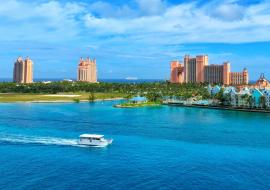Exploring the Four A's of Travel and Tourism

By Jorge Coromina
In the dynamic world of travel and tourism, crafting unforgettable experiences for travelers has become an art form. To achieve this, industry professionals have developed various strategies and frameworks, one of the most notable being the Four A's of Travel and Tourism.
The Four A's of Travel and Tourism – Accessibility, Accommodation, Attractions, and Activities – provide a comprehensive framework for understanding the key elements that contribute to exceptional travel experiences.
The success of the industry hinges on its ability to continually innovate and adapt to changing traveler preferences, technological advancements, and global challenges.
By prioritizing these four elements, travel and tourism professionals can ensure that each journey becomes an enriching and memorable adventure.
This model emphasizes four crucial elements that contribute to creating remarkable and meaningful journeys for travelers worldwide.
Accessibility
Accessibility is the cornerstone of any successful travel and tourism experience. It refers to the ease with which travelers can reach a destination. Modern transportation systems, including air travel, railways, road networks, and even maritime routes, have significantly contributed to making the world more interconnected. Improved accessibility not only allows people to explore far-flung destinations but also helps local economies thrive by promoting tourism.
Furthermore, accessibility extends beyond physical transportation. It also encompasses factors such as visa policies, language barriers, and the availability of information. With the advent of technology, access to information about destinations, accommodations, and activities has become easier than ever, enabling travelers to make informed choices and plan their trips effectively.
Accommodation
Accommodation plays a vital role in shaping the overall travel experience. From luxury resorts to boutique hotels, cozy bed-and-breakfasts to innovative hostels, the variety of lodging options available today caters to diverse traveler preferences and budgets. Accommodation is not just a place to rest; it's an integral part of the destination experience.
Modern travelers seek more than just a place to sleep – they desire authentic and immersive experiences. Accommodation providers have responded by incorporating local culture, design, and architecture into their offerings. This trend allows travelers to fully immerse themselves in the destination's ambiance, contributing to a deeper connection with the local community.
Attractions
Attractions are the heart and soul of any travel destination. They include historical landmarks, natural wonders, cultural sites, entertainment venues, and more. The diversity of attractions in a destination contributes to its allure, catering to various interests and passions.
Sustainable tourism practices emphasize the importance of preserving and respecting these attractions. Overcrowding and mismanagement can lead to degradation of natural sites and cultural heritage. Therefore, responsible tourism seeks to strike a balance between offering visitors exceptional experiences while safeguarding the integrity of attractions for future generations.
Activities
Activities encompass the experiences and adventures that travelers engage in during their journeys. These range from adrenaline-pumping outdoor activities like hiking, diving, and skiing to cultural experiences such as culinary tours, workshops, and performances. Activities are what transform a passive trip into an active and engaging exploration.
The rise of experiential travel reflects the growing demand for immersive and authentic activities that allow travelers to connect with locals, learn new skills, and gain a deeper understanding of a destination's way of life. This shift has led to the development of unique itineraries and off-the-beaten-path experiences that cater to curious and adventure-seeking travelers.














